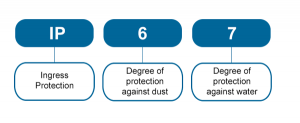Confused by IP ratings? This guide deciphers the codes, explaining how they shield your electronics from dust and water. Dive in and find the right protection for your gear!
Key Takeaways:
- IP ratings are two-digit codes indicating an enclosure’s protection against dust and water.
- The first digit rates dust protection, and the second for water.
- Higher numbers mean better protection in harsh environments.
Q: What do IP ratings mean?
A: IP ratings are a two-digit code that indicates the level of protection an enclosure provides against dust and water. The first number is for dust protection and the second number is for water protection. Higher numbers indicate greater protection. For example, an IP67 enclosure is dustproof and can withstand being submerged in up to 1 meter of water for 30 minutes.
What are IP (Ingress Protection) ratings? IP ratings Explained
IP (Ingress Protection) ratings are a standard used to classify the level of protection provided by enclosures for electrical equipment. The IP rating consists of two numbers, each of which represents a different aspect of the enclosure’s protection. The first number represents the level of protection against solid objects (such as dust) entering the enclosure, and the second number represents the level of protection against water.
For example, an enclosure with an IP rating of “IP65” would be protected against low-pressure jets of water from all directions, but would not be protected against submersion. An enclosure with an IP rating of “IP67” would be protected against immersion in water up to a certain depth for a specified amount of time.
In general, the higher the IP rating, the greater the level of protection provided by the enclosure. It is important to select an enclosure with an appropriate IP rating for your equipment, depending on the specific requirements and potential environmental factors.
How to Read Ratings with Two or Three Numbers
There are two or three numbers in an IP rating. The first number refers to defence against solid objects or materials, the second number refers to defence against liquids, and the third number, which is sometimes left out of the grade, refers to defence against mechanical impacts.

| Rating | First Number | Second Number | Third Number |
| 0 | No Protection | No Protection | No Protection |
| 1 | Protection from solid foreign objects of 50mm or greater | Protection from vertically falling water drops and condensation | Protection from impact of 0.225 joules (equal to 150 grams falling 15cm) |
| 2 | Protection from solid objects up to 12mm | Protection from direct sprays of water up to 15 degrees from vertically | Protection from impact of 0.375 joules (equal to 250 grams falling 15cm |
| 3 | Protection from solid objects more than 2.5 mm | Protection from direct sprays of water up to 60 degrees from vertically | Protection from impact of 0.5 joules (equal to 250 grams falling 20cm |
| 4 | Protection from solid objects more than 1mm | Protection from splashing water in all directions | Protection from impact of 2 joules (equal to 500 grams from 40cm |
| 5 | Protection from dust, limited ingress | Protection from low-pressure water jets in all directions | Protected from impact of 6 joules (equal to 1.5 Kilos falling from 40cm) |
| 6 | Total protection from dust(dust-tight) | Total Protection from high-pressure water jets | Protection from impact of 20 joules (equal to 5 Kilos falling 40cm |
| 7 | N/A | Protection from immersion in water up to 1 metre for 30 minutes | N/A |
| 8 | N/A | Protection from long periods of immersion while under pressure | N/A |
So, there you have it! IP ratings – not so mysterious anymore, right? Remember, higher numbers mean tougher shields. Pick the right rating for your playground, and your tech will thank you for it!
